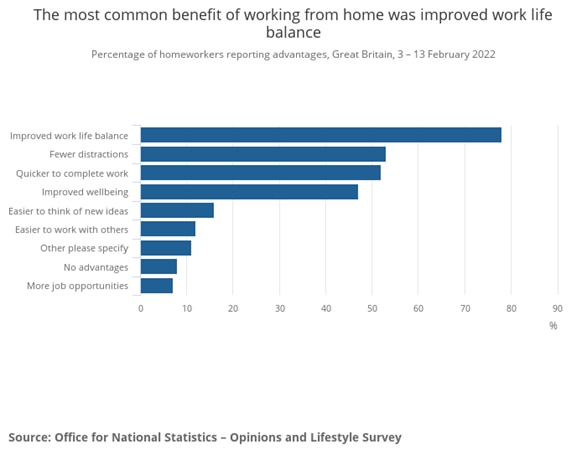Working From Home Statistics 2022: Why Employees Want To WFH
By Varun Bodhi

Since the coronavirus, working from home is no stranger to the UK but employees are now accustomed to a flexible workstyle and it has become highly desirable. Working from home statistics show a trend of people wanting jobs which offer flexibility and being in an office five days per week is starting to become less favourable.
Let’s have a look at what the working adults have to say about the future of workstyles through remote work statistics.
The Story Through Numbers
According to the Office for National Statistics (ONS) in the UK, up to 84% of workers which were made to work from home because of Covid, now plan to work in a hybrid setting. Interestingly, correlation can be observed between those who are able to work hybrid and those who can’t, with salary being the determining factor.
ONS’ remote work statistics indicate that higher earners were more likely to work hybrid than lesser earners. With only 8% of employees earning up to £15,000 working hybrid and 32% of employees earning between £30,000 - £40,000 working hybrid – the difference is clear.

Remote work statistics also indicate that hybrid work was more common amongst people aged 30 to 49. Now, up to 62% of employees expect their employers to let them work remotely which means it has become more of an expectation than request.
Flexibility is Invaluable
According to remote work statistics in the UK, flexibility is argued as the biggest benefit. With up to 50% of people voting flexibility as the primary benefit, this branches off into many positives.
For example, while working from home people are able to mitigate their commute to work and home. The average UK worker commutes around 59 minutes a day travelling to work, which when combined with the time needed to get ready can average near two hours.
Having an extra two hours in the morning gives people time to exercise or enjoy better quality sleep which can impact productivity levels. Flexibility is also commonly tied to work life balance as people indicate a high preference of having more autonomy over their choice of work location.
In fact, McKinsey’s remote work statistics suggest that talent may be at risk for businesses which decide to revert to a fully on-site model. Up to 25% of people would consider choosing another organisation if they were made to work in-person every day, creating a strong indication of people’s preference for work-life balance and flexibility.
Improved Productivity
Remote work statistics suggest that workers are approximately 13% more productive when working from home and about 77% of employees which work from home a few times per month display an increase in productivity.
There is a perception amongst workers that productivity improves when they are awarded flexible conditions because it links to a better work life balance. Workers have more time to do regular life tasks which otherwise need to be delayed till the weekend and as a result they are more motivated to perform at work.
People have become appreciative of employers which provide them with flexibility and some individuals would even consider a slight pay cut to work in their ideal conditions. This remote work statistic can be seen globally, with sources citing that more than two-thirds of hybrid workers are willing to endure a pay cut to maintain the same work conditions.
Businesses are also experiencing productivity gains because remote workers are working longer hours. When people are in the office majority will ensure to leave on time, however when working from home there are many people which are happy to work past 5pm because there is no commute time and they’re in the comfort of home.
Regardless of working from home, employees can still work with each other effectively by using the best collaboration tools for remote teams.
Employees save Money
Remote work statistics also highlight that employees save a significant amount of money by working from home. Before the pandemic, UK workers spend between £1,536–£3,840 every year just to get to work.
Now that employees have experienced the benefits of flexibility even on their wallets, many are recognising the costs involved in simply turning up to work is too high. To further add to the problem, now that inflation has increased the cost of living across the board, people are being wary of all costs.
Working from home mitigates the costs associated with the daily commute to work and for those in the lower income bracket, it can make a big difference.
Potential Environment Benefits
Although environmental implications are still up for debate, remote work statistics hint that there are some benefits. While it may not be a large percentage, working remotely would reduce the traffic on the road as people would not need to drive to work.
The UK doesn’t have remote work statistics on the carbon emissions impact, however numbers from the Global Workplace Analytics say that greenhouse gas emissions from vehicle travel may reduce up to 51 million metric tons a year if everyone worked remotely half the time.
This suggests that working hybrid has its own environmental merits, however as mentioned earlier the clarity on whether remote working or hybrid is the best working style for the environment is not so black and white.
During the peak of pandemic, more than seven million people in the UK spent an average of £233 to buy office supplies and make their home suitable for work. This equates to millions of office supplies being purchased and creates the issue of buying twice the amount of office supplies per person.
While working hybrid, employees will require the same supplies at the office and home.
Better Job Satisfaction
Job satisfaction has become extremely important and the Great Resignation echoes this strongly. Not many people are willing to work occupations they dislike and a lot of workers have been more willing to experiment career changes to find something that satisfies them.
Remote work statistics from a well-known study portrayed an interesting finding, suggesting that job satisfaction does increase with telecommuting, however this satisfaction plateaus at 15.1 hours per week. This means that people do desire some face-to-face interactions at work and always staying home for work isn’t optimal.
Considering the average work day is 8 hours, if we were to round up the number provided by the study it shows us that job satisfaction is at its peak when telecommuting is allowed for 16 hours per week. This means that a split between two days of working remotely and three days in the office is the ideal balance for the majority of people, hence showing hybrid is very important for job satisfaction.
Remote work statistics discussed by the Forbes also agree that happiness at work increases by 20% when being allowed to work remotely. That is a significant increase in happiness and considering the same study mentions 27% of happiness at work explains happiness in life – work conditions contribute a strong amount in our lives.
No Longer Tied via Location
There are many people which are suitable for particular roles but can’t apply because the location may be too far. Remote working opens up the opportunity for a global talent pool and workers would be able to apply for more roles than ever.
Remote work statistics mention that 56% of global companies allow remote work, which is a strong indicator that businesses are able to leverage from a greater talent pool than those which don’t offer remote work.
If planned adroitly, remote work gives businesses the ability to operate 24/7 by having employees spread across different time zones.
Fewer Sick Days
While it may seem that remote working only benefits employees, there are actual a handful of employer perks as well. Remote working statistics indicate that employees are less likely to take sick days.
This derives from two reasons; the first being reduced in-person interactions means people can’t spread sickness and secondly, workers will often take sick leave just because they feel too tired to commute to the office.
When remote work is in place, employees are likely to work even when they are mildly unwell but if they are required to commute to work then using a sick day is likely. According to remote work statistics, businesses lose around £2032 per employee, per annum.
With workers taking fewer sick days your business doesn’t reduce its productivity and employees are still getting their important tasks complete.
Operations Continuity
Businesses will often have to deal with situations where productivity in the office may pause. Either due to renovations, shifting locations or an IT outage, by working remotely you ensure continued operations consistently.
On average, downtime can cost small-to-medium businesses between £4503 and £14,073 per hour. According to remote work statistics, this number is far greater for larger enterprises.
Although IT outages can still be experienced while working remotely, the issue will only effect the individual as not everyone is working from the same location. Remote working enables better operational continuity and as a result benefits businesses down the line.
Dressing Comfortably
Spending cash on office clothes is also a cost workers can save on.
When workers were asked if they wear something special before video calls, 58% responded with ‘no’. Surprisingly, up to 42% of employees said they would look to leave their current job if stricter dress codes were imposed for remote working.
Remote work statistics are strongly supporting the notion of employees seeking flexibility in all aspects, including dress code which saves money down the line.
Contact Us
If you’ve got any questions call us 020 3205 7200 or fill in your information below and we’ll get back to you shortly.





